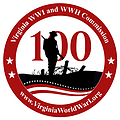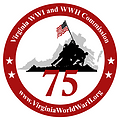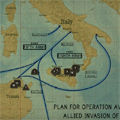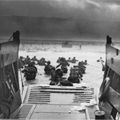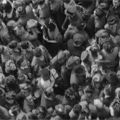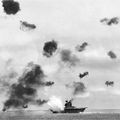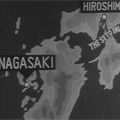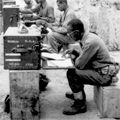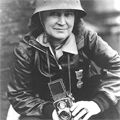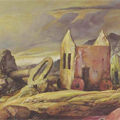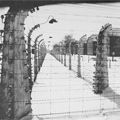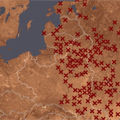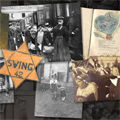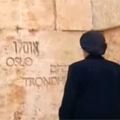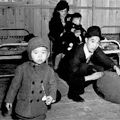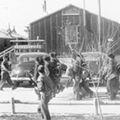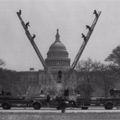Using political cartoons by Dr. Seuss to examine isolationism in America is the war intensified in Europe.
Students examine the a radar plot from Hawaii on December 7, 1941, showing evidence of the incoming attack.
Comparing FDR's final speech to Congress to an early draft.
Primary source documents and activities paired with short video documentaries on WWII, beginning in the years before the U.S. was involved in the war. See documents and activities and playlist of short documentaries.
Students examine the a radar plot from Hawaii on December 7, 1941, showing evidence of the incoming attack.
Comparing FDR's final speech to Congress to an early draft.
Students use primary and secondary sources to prepare a brief for General Eisenhower, advising him on how to proceed in planning the D-Day invasion. (See also Eisenhower and the Troops and Art of Deception: Selling a Story to the German Army)
Students examine the Battle of the Bulge through primary and secondary source readings.
Four lessons detailing the progression of the war up to its end in Europe and in the Pacific. Lessons 2 and 3 focus on Europe.
Significant moments in WWII explored through primary source documents, with emphasis on MacArthur and the Pacific Theater.
Students learn the basic geography of the Pacific Theater.
Four lessons detailing the progression of the war up to its end in Europe and in the Pacific. Lessons 1 and 4 focus on the Pacific.
Students examine the dropping of the atomic bomb from four different perspectives.
Examines the role of the all-African American military supply unit.
Students learn about the role of WASPs during WWII.
Students examine the effects of FDR's 1941 Executive Order providing equal opportunity in defense industries and the subsequent establishment of the Fair Employment Practices Commission.
Online module examining how new opportunities for employment and involvement in civic life affected marginalized groups.
Examining the social tensions surrounding women entering the workforce in WWII. See also The Changing Face of Woman.
Students use historical documents and newsreels to examine the internment of Japanese Americans during WWII.
Activities relating to the documentary Bataan Rescue, detailing the experiences of POWs in the Pacific.
Aligned to Virginia's Standards of Learning for History and Social Science

Lesson Plans
Resources
9th
Grade
SOL VUS.11a: The student will apply social science skills to understand World War II by analyzing the causes and events that led to American involvement in the war, the Japanese attack on Pearl Harbor, and the American Response
SOL VUS.11b: The student will apply social science skills to understand World War II by describing and locating the major battles and key leaders of the European theater
SOL VUS.11c: The student will apply social science skills to understand World War II by describing and locating the major battles and key leaders of the Pacific theater
SOL VUS.11d: The student will apply social science skills to understand World War II by evaluating and explaining how the U.S. mobilized its economic and military resources, including the role of all-minority military units and the contributions of media, minorities, and women to the war effort
SOL VUS.11f: The student will apply social science skills to understand World War II by evaluating and explaining the treatment of prisoners of war and civilians by the Allied and Axis powers
The Naples-Foggia Campaign, Anzio and Rome-Arno Campaigns, Battle of the Atlantic, Normandy Campaign
American Battle Monuments Commission
Interactive maps and timelines of major campaigns in WWII.
Short videos on D-Day, with emphasis on Eisenhower's role. See also Eisenhower Interactive Timeline.
- USS Franklin War Damage Report
- Memorandum approving the award of the Medal of Honor for Desmond Doss
Photo archive of African Americans in all branches of service an don the home front during WWII.
Women Come to the Front: Journalists, Photographers, and Broadcasters During WWII
Exhibit on women on the front lines during the war.
- Desegregation of the Armed Forces
- House Resolution Establishing the Women's Army Auxiliary Corps
United States Holocaust Memorial Museum
Searchable encyclopedia of topics related to the Holocaust. See also Guidelines for Teaching about the Holocaust.
Holocaust History Animated Maps
United States Holocaust Memorial Museum
Animated maps detailing the scope and impact of the Holocaust.
Some Were Neighbors: Collaboration & Complicity in the Holocaust
United States Holocaust Memorial Museum
Online exhibition examining citizens' roles in allowing the Holocaust to happen.
Online exhibit featuring the story of Seattle's Japanese American community in the spring and summer of 1942.
Date Which Will Live in Infamy
Interactive article on the attack on Pearl Harbor. See also Remembering Pearl Harbor (interactive map).
History, Art, & Archives from the United States House of Representatives
Videos from the U.S. House of Representatives relating to the declaration of war.
SOL VUS.11e: The student will apply social science skills to understand World War II by analyzing the Holocaust (Hitler's "final solution"), its impact on Jews and other groups, and the postwar trials of war criminals
